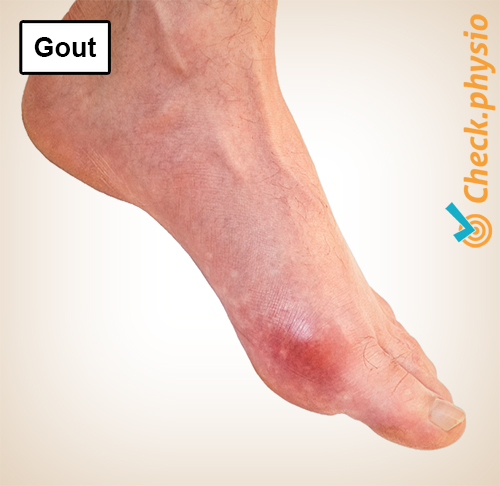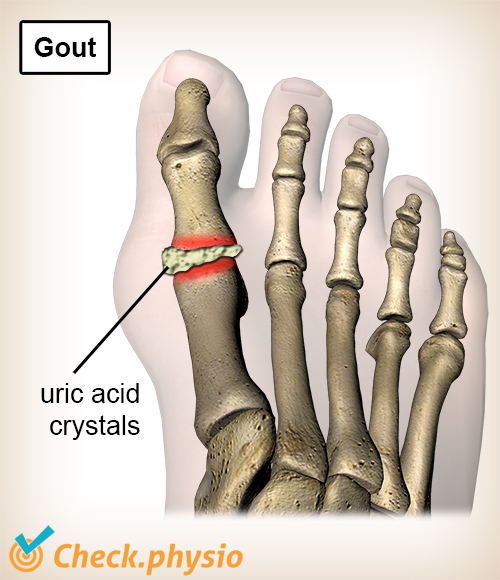- Conditions
- Gout
Gout Gout arthropathy / Gout arthritis
Introduction
Gout is a condition where uric acid crystals accumulate in one or more joints. This provokes an inflammatory response and causes severe pain. Gout usually occurs in the big toe or foot.
Gout exists in an acute and a chronic form. The condition is particularly common in men aged 40 and over. However, this does not mean that women and young people cannot get gout.

Description of condition
Gout is a rheumatic condition that causes inflammation of the joints. The surrounding tendons and bursae may also be affected.
In its acute form, a highly painful joint inflammation occurs suddenly. This is sometimes, especially in larger joints, accompanied by fever. The big toe is usually the first joint to be affected, but in principle it can occur in any joint. An acute gout attack may remain a one-off event, or it may recur frequently or develop into chronic gout. The last is the case for about two out of three people.
It is also possible for chronic gout to develop without having been preceded by one or more acute gout attacks. The symptoms then more resemble rheumatoid arthritis or osteoarthritis, persist for a long(er) time and possibly spread to other joints. A clear sign that this is indeed gout is the presence of tiny white lumps (tophi).These tophi occur in about 5-10% of the people with gout and are filled with a thick, chalk-like substance that exits when the skin of a tophi ruptures. Tophi may often be found in the following areas:
- Fingers and toes.
- Auricle (outer ear).
- Forearm.
- Achilles tendon.
- Back of the elbow.
- Front of the knee.
Cause and history
Uric acid occurs in everyone's body as a waste product of your metabolism. Problems arise when the body does not absorb uric acid properly or produces too much of it. The uric acid is then not excreted fast enough, causing uric acid crystals to accumulate in joints, bursae or along tendons. The body reacts to this with an inflammatory response. It is then very painful to place any load on the red and swollen body part.
We do not yet know an exact cause for the development of gout. There is a relationship between the use of certain medication (diuretics), cardiovascular conditions, and reduced kidney function. Genetics and advancing age also play a role.
In addition, there appear to be a number of lifestyle factors that increase the risk of developing gout or triggering a gout attack. But this cannot be said with certainty. This may include, among other things:
- (Excessive) consumption of alcohol.
- Foods high in purine (some meats and fish).
- Excess weight.
- Prolonged severe stress.
Signs & symptoms
Typical symptoms that occur in case of gout are:
- It usually comes on quickly in one or more joints.
- Often the big toe is the first to be affected.
- Painful and inflamed (swollen, red, warm) joints, tendons and/or bursae.
- Pain when moving and placing a load on the affected joint.
- Presence of tophi.
Diagnosis
During examination by a physician, they will ask questions to determine what the problem is. A physical examination follows that looks for inflammatory signs in the affected joint and the presence of tophi.
Blood tests and a joint puncture can detect gout. In a joint puncture, the physician extracts a small amount of fluid from the inflamed joint with a needle. A laboratory technician then looks for uric acid crystals under a microscope.
Treatment and recovery
Gout affects everyone differently. A single gout attack usually clears up completely without permanent damage within 1 to 3 weeks. If the gout recurs more frequently or becomes chronic then the risk of permanent joint damage increases.
Medication helps to treat gout and to prevent (further) joint damage. It combats the inflammation, prevents new inflammation and/or lowers the level of uric acid. Lifestyle modifications with adequate exercise and a healthy eating and drinking pattern help prevent new gout attacks.
More info
You can check your symptoms using the online physiotherapy check or make an appointment with a physiotherapy practice in your locality.
References
Janssens, H.J.E.M., Lopuhaä, D.E., Schaafstra, A., Shackleton, D.P., Van der Helm-Van Mil, A.H.M., Van der Spruit, R., Van Peet, P.G., Wiersma, Tj. & Woutersen-Koch, H. (2017) NHG-Standaard. Artritis (M90) Nederlands Huisartsen Genootschap. Versie 2.0, november 2017.

